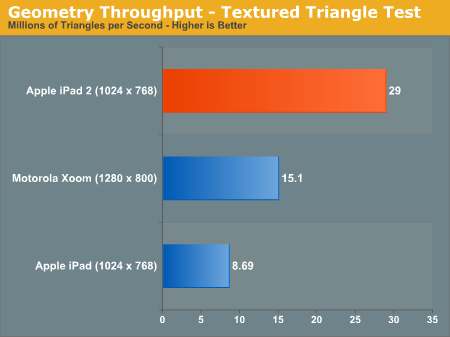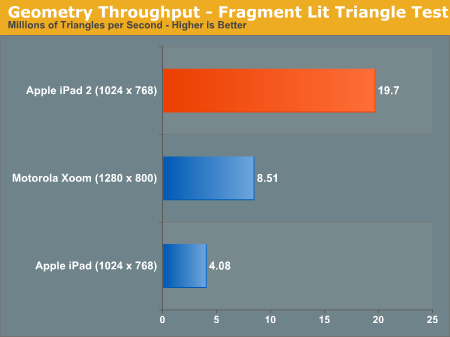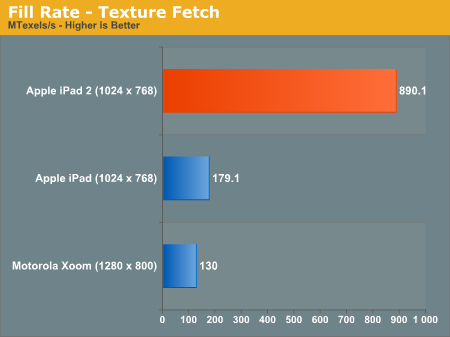Apple iPad 2 GPU Performance Explored: PowerVR SGX543MP2 Benchmarked
by Anand Lal Shimpi on March 12, 2011 3:04 PM EST- Posted in
- Smartphones
- Apple
- iPad
- GLBenchmark
- iPad 2
- Mobile
- Tablets
Earlier this morning we published our first impressions on Apple's iPad 2, including analysis on camera quality and a dive into the architecture behind Apple's A5 SoC. Our SoC investigation mostly focused on CPU performance, which we found to be a healthy 50% faster than the A4 in the original iPad - at least in web browsing. We were able to exceed Apple's claim of up to 2x performance increase in some synthetic tests, but even a 50% increase in javascript and web page loading performance isn't anything to be upset about. We briefly touched on the GPU: Imagination Technologies' PowerVR SGX 543MP2. Here Apple is promising up to a 9x increase in performance, but it's something we wanted to investigate.
Architecturally the 543MP2 has more than twice the compute horsepower of the SGX 535 used in Apple's A4. Each shader pipeline can execute twice the number of instructions per clock as the SGX 535, and then there are four times as many pipes in an SGX 543MP2 as there are in a 535. There are also efficiency improvements as well. Hidden surface removal works at twice the rate in the 543MP2 as it did in the 535. There's also a big boost in texture filtering performance as you'll see below.
As always we turn to GLBenchmark 2.0, a benchmark crafted by a bunch of developers who either have or had experience doing development work for some of the big dev houses in the industry. We'll start with some of the synthetics.
Over the course of PC gaming evolution we noticed a significant increase in geometry complexity. We'll likely see a similar evolution with games in the ultra mobile space, and as a result this next round of ultra mobile GPUs will seriously ramp up geometry performance.
Here we look at two different geometry tests amounting to the (almost) best and worst case triangle throughput measured by GLBenchmark 2.0. First we have the best case scenario - a textured triangle:

The original iPad could manage 8.7 million triangles per second in this test. The iPad 2? 29 million. An increase of over 3x. Developers with existing titles on the iPad could conceivably triple geometry complexity with no impact on performance on the iPad 2.
Now for the more complex case - a fragment lit triangle test:

The performance gap widens. While the PowerVR SGX 535 in the A4 could barely break 4 million triangles per second in this test, the PowerVR SGX 543MP2 in the A5 manages just under 20 million. There's just no competition here.
I mentioned an improvement in texturing performance earlier. The GLBenchmark texture fetch test puts numbers to that statement:

We're talking about nearly a 5x increase in texture fetch performance. This has to be due to more than an increase in the amount of texturing hardware. An improvement in throughput? Increase in memory bandwidth? It's tough to say without knowing more at this point.
| Apple iPad vs. iPad 2 | ||||
| Apple iPad (PowerVR SGX 535) | Apple iPad 2 (PowerVR SGX 543MP2) | |||
| Array test - uniform array access |
3412.4 kVertex/s
|
3864.0 kVertex/s
|
||
| Branching test - balanced |
2002.2 kShaders/s
|
11412.4 kShaders/s
|
||
| Branching test - fragment weighted |
5784.3 kFragments/s
|
22402.6kFragments/s
|
||
| Branching test - vertex weighted |
3905.9 kVertex/s
|
3870.6 kVertex/s
|
||
| Common test - balanced |
1025.3 kShaders/s
|
4092.5 kShaders/s
|
||
| Common test - fragment weighted |
1603.7 kFragments/s
|
3708.2 kFragments/s
|
||
| Common test - vertex weighted |
1516.6 kVertex/s
|
3714.0 kVertex/s
|
||
| Geometric test - balanced |
1276.2 kShaders/s
|
6238.4 kShaders/s
|
||
| Geometric test - fragment weighted |
2000.6 kFragments/s
|
6382.0 kFragments/s
|
||
| Geometric test - vertex weighted |
1921.5 kVertex/s
|
3780.9 kVertex/s
|
||
| Exponential test - balanced |
2013.2 kShaders/s
|
11758.0 kShaders/s
|
||
| Exponential test - fragment weighted |
3632.3 kFragments/s
|
11151.8 kFragments/s
|
||
| Exponential test - vertex weighted |
3118.1 kVertex/s
|
3634.1 kVertex/s
|
||
| Fill test - texture fetch |
179116.2 kTexels/s
|
890077.6 kTexels/s
|
||
| For loop test - balanced |
1295.1 kShaders/s
|
3719.1 kShaders/s
|
||
| For loop test - fragment weighted |
1777.3 kFragments/s
|
6182.8 kFragments/s
|
||
| For loop test - vertex weighted |
1418.3 kVertex/s
|
3813.5 kVertex/s
|
||
| Triangle test - textured |
8691.5 kTriangles/s
|
29019.9 kTriangles/s
|
||
| Triangle test - textured, fragment lit |
4084.9 kTriangles/s
|
19695.8 kTriangles/s
|
||
| Triangle test - textured, vertex lit |
6912.4 kTriangles/s
|
20907.1 kTriangles/s
|
||
| Triangle test - white |
9621.7 kTriangles/s
|
29771.1 kTriangles/s
|
||
| Trigonometric test - balanced |
1292.6 kShaders/s
|
3249.9 kShaders/s
|
||
| Trigonometric test - fragment weighted |
1103.9 kFragments/s
|
3502.5 kFragments/s
|
||
| Trigonometric test - vertex weighted |
1018.8 kVertex/s
|
3091.7 kVertex/s
|
||
| Swapbuffer Speed |
600
|
599
|
||
Enough with the synthetics - how much of an improvement does all of this yield in the actual GLBenchmark 2.0 game tests? Oh it's big.











219 Comments
View All Comments
GnillGnoll - Sunday, March 13, 2011 - link
Motorola Xoom is actually rendering at 1280x752, since the System Bar in Honeycomb is always taking up screen space.LordSojar - Sunday, March 13, 2011 - link
The comments in this section are a big joke. You've all been owned by corporate marketing strategy and product placement.How about... people buy whatever the hell they want to buy, and you don't comment on their purchase versus your own. That's a novel concept... shutting your mouths and letting others be content with their purchases.
You Apple folk, take your iPad praises elsewhere, you won't convince Android users that your device is better...
In addition, you Android folk, take your iPad bashing elsewhere, you won't convince iOS users that anything aside from an Apple device is better.
Now can the rest of you shut the hell up about the devices? This thread is about the GPU in the SoC, not the device.
Nigra - Sunday, March 13, 2011 - link
For the people pointing out the resolution difference, it really doesn't say much... but I'm sure you know this already... anyways, read on:I've taken the most favorable benchmark for the xoom (the first one) and made the math:
1024*768@29fps = 22806528 pixels/second
1280*800@15.1fps = 15462400 pixels/second
So, it's still a much much lower score... and this is optimistic since I'm taking the best benchmark for the xoom... but all of the other benchmarks just worsen it.
Also, take as example how AA on the iPad results much better than no AA on the xoom at all, even when the iPad must render a bigger picture of the scene to fit it on the display later.
kmmatney - Sunday, March 13, 2011 - link
As others have commented, the XOOM renders at 1280 x 752, since the Honeycomb menu bar is always on the screen, so the best case benchmark for XOOM is slightly lower:1280 * 752 @ 15.1 fps = 14534656 pixels/sec
PeteH - Monday, March 14, 2011 - link
Are the XOOM benchmark tests unable to remove the menu bar and render full screen?GnillGnoll - Tuesday, March 15, 2011 - link
Android 3.0 ("Honeycomb") applications cannot completely hide the System Bar since it contains the Home/Back/Task Switch buttons which are crucial for using the device. Apps can only enable a "lights out" mode which will dim the System Bar until you touch it, but they can never use the entire screen.PeteH - Tuesday, March 15, 2011 - link
Hmm, that seems odd. Does the "lights out" mode allow for the System Bar to go semi-transparent?MacAtDBB - Sunday, March 13, 2011 - link
Thanks for a great review. Looking at the POWERVR SGX543MP specs I see it supports various modes of GP-GPU including OpenCL. I wonder if Apple are (or will be) exploiting this in the iOS as they seem to be is snow leopard?tipoo - Monday, March 14, 2011 - link
They don't actually use OpenCL in Snow Leopard, OpenCL is available for use by developers within Snow Leopard. The two things are distinctly different. I imagine its the same for this.jmcb - Sunday, March 13, 2011 - link
I was never sold on Tegra 2 for battery life alone based on some stuff I read last year. The PowerVR looks like it doesnt wanna be left out of the specs talks. Which is good, cuz it proved last year to be one of the best gpu's in mobile devices along with Tegra 2.Like I said I was leery on Tegra 2 just on battery life.....and based on this article.....I will definitely wait til some other phones with different chips come out.